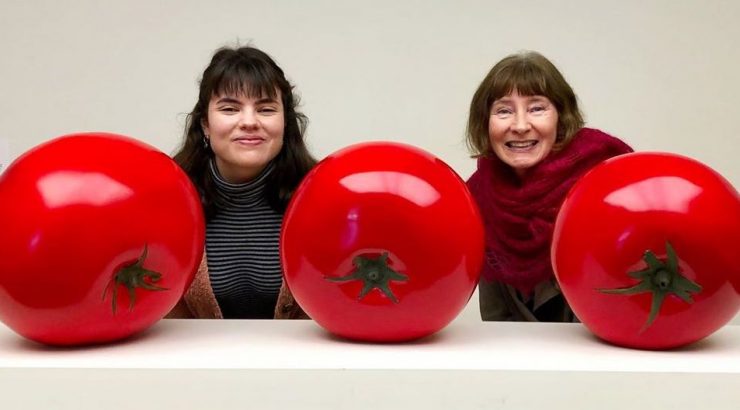
Celebrating Women’s History Month A spotlight on the works of Jessica Rath and Jenny Yurshansky.
March 23, 2020
According to a story by Pliny the Elder, a Roman writer from the first century C.E., the first drawing ever made was a portrait of a lover by a woman named Dibutades. After tracing the silhouette on the wall, Dibutades’ father created a clay model of the drawing. To no surprise, in Pliny the Elder’s writing, it is Dibutades’ father who gets praise for the invention of ‘the art of modeling.’ Dibutades’ silhouette was overshadowed.
Like most other professions, work by female artists has gone largely unnoticed. Between 2008 and 2018, only 11 percent of art acquired by the country’s top museums for their permanent collections were by women. With this in mind, the Escalette Collection has shown great effort to break the mold. According to a blog last year by the Escalette Collection,“Today, over half of new acquisitions by Art Collections were made by women artists.”
In honor of women’s history month, the Escalette Collection spotlights two female artists whose work has recently joined the collection. These women are Jenny Yurshansky and Jessica Rath who both use their art to explore the relationship between human and natural worlds.
Jessica Rath’s work unpacks the complicated history of the food around us. Rath’s project “Take Me to the Apple Breeder” – which marries sculptures and photographs – grew from a visit to the Plant Genetics Resource Unit (PGRU) in Geneva, New York. Here, apple buds from trees around the world are collected and grafted to make new trees and bear lost fruit. This process keeps a variety of apple trees alive, saving several apple species from extinction.
The diversity of the grafted trees was mind-blowing to Rath, so she documented the process through photographs and sculptures. She created nine apple sculptures, based on examples of varieties from PGRU. Alongside the sculptures, Rath curated six photographs of the grafted trees “to catch the beautiful, leafless silhouettes and the sensuous detail of their skin.”
- “Clone Weeping With Resistance” by Jessica Rath.
- “Kazakhstan Elite” by Jessica Rath.
- “Clone Water Sprout” by Jessica Rath.
Rath’s project, “Take Me To the Apple Breeder,” continues with global research in the Tian Shan Mountains of Kazakhstan where one can find Malus sieversii, the original edible apple that grows in the last expansive wild apple forests on earth. In the U.S., PGRU holds 950 seed lots of Malus sieversii in cold storage. About 2,808 seedlings are being grown from these seed lots as trees for field evaluation. Kazakhstan is the one place where apples are left to grow wild, but because of deforestation for firewood, this delicacy is nearing extinction. Rath’s work comments on the destruction, highlighting the beauty of these trees and their fruits.
Just as plants move across borders for all sorts of reasons, people move too. This idea is prevalent in the work of Jenny Yurshansky.
Yurshansky was born stateless in Rome by way of Soviet-era Moldova. Her parents fled from Moldova in 1978. They headed to L.A., where Yurshansky was born en route on an island in the Tiber River of Rome. Yurshansky’s work is deeply informed by her refugee identity and her research mind. She desired to return to Moldova and explore her roots, which she eventually did through her art. In some of her work, Yurshansky uses plant themes to explore the trauma of human displacement.
“Blacklisted: A Planted Allegory,” by Yurshansky, discusses the history of invasive plant species. Invasive species are aggressive competitors with potential to displace the native plants in biomes they share. She explores the complexity of this invasive-native relationship, noting how these invasive species have found common place in native California cuisine, garden, and landscape.
For this project, Yurshansky collected and researched 168 invasive plants in northern Norway. She found 62 of them were on the “Black List,” meaning their invasive threat level was “Very High” or “Unknown.” She created a hand-cut silhouette portrait of each one.
- “Blacklisted: A Planted Allegory (Herbarium) – Kentucky Bluegrass, 2015” by Jenny Yurshansky.
- “Blacklisted: A Planted Allegory (Herbarium) – Indian Tree Tobacco, 2015” by Jenny Yurshansky.
The creative process of each of these women is worth noting. Both desire to explore the human experience with an emphasis on research. This component brings great depth and beauty to their art.
Though women artists have a history of being overshadowed, Yurshansky and Rath are two of the many artists proving that their creative minds have a valued place at the table.
The Escalette Collection has been growing its collection of women artists for quite some time and is committed to foregrounding the work of women’s artists all year round, not just during Women’s History Month.

The heart and soul of the Escalette Collections – Jessica Bochinski (left) and Linsday Shen (right) – stand behind three tomatoes, part of the series Ripe, by Jessica Rath. Ripe is based on the history of genetic manipulation of tomatoes.
We invite you to explore all the works in the Escalette Collection by visiting our eMuseum.
Wilkinson College of Arts, Humanities, and Social Sciences is the proud home of the Phyllis and Ross Escalette Permanent Collection of Art. The Escalette Collection exists to inspire critical thinking, foster interdisciplinary discovery, and strengthen bonds with the community. Beyond its role in curating art in public spaces, the Escalette is a learning laboratory that offers diverse opportunities for student and engagement and research, and involvement with the wider community. The collection is free and open to the public to view.






